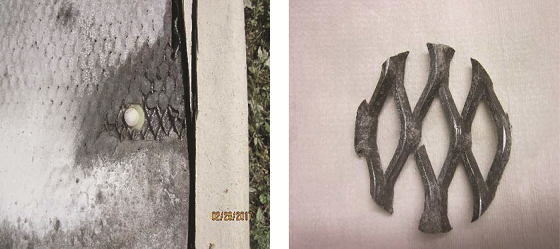Bridges located in coastal areas are subjected to harsh conditions and suffer the deleterious effects of corrosion. Thousands of bridges in Florida (USA), most of which are constructed with steel reinforced concrete, are located in marine environments and suffer from saltwater-induced corrosion. Most of these bridges are supported by precast pilings that are either continuously or periodically exposed to saltwater, requiring cathodic protection (CP).
Researchers Douglas L. Leng with Structural Technologies, LLC; Matthew Duncan with Florida Department of Transportation, Corrosion Research Laboratory; and Ivan R. Lasa with Lasa and Associates Corrosion Services studied two decommissioned pilings from the Veterans Memorial Bridge in Florida. This bridge was constructed in 1954 and crosses the Halifax River—which is considered a marine site—in Daytona Beach, Florida. As part of the Florida Intracoastal Waterway, the Halifax River is high in chlorides.
Zinc mesh CP jackets were used on the pilings to provide corrosion protection from the aggressive marine environment, which have been proven effective in providing long-term galvanic protection to steel reinforced concrete piles in similar environments in both laboratory and field trials (Figure 1). In fact, research has shown that this approach can mitigate corrosion and lengthen service life by greater than 20 years.
After being in service for many years with only minor repairs, the Veterans Memorial Bridge underwent an extensive condition assessment in 1992. The bridge components, such as the concrete piles, fender system, concrete pile caps, concrete beams, and concrete deck, were inspected and rated to assess their condition. In 1994, another review was completed, which found the bridge to be in structurally sound condition, but to remain so, the concrete piles would soon need repair. The decision was made to repair 133 piles using galvanic zinc mesh CP jackets. The repairs began in the fall of 1994 and were completed in 1995.
Because it did not meet the latest deck codes and guardrail safety requirements, the Veterans Memorial Bridge was closed for decommissioning in July 2016. The bridge seemed to be in good shape, and although they had been in service for over 20 years, the galvanic zinc mesh jackets were still performing as designed. The bridge obtained a sufficiency rating of 49.7, at which time it was labeled “functional obsolete.”

From the top of the pile, the high-tide zone was determined to be 8 ft (2.44 m), and the low-tide zone was 11 ft (3.35 m). The researchers reached this conclusion by measuring the water marks and marine growth on the pile and jacket, in addition to consulting local environmental data (Figure 2). They drilled 2-in (50.8-mm) diameter cores at 6-in (152.4-mm) intervals outside the jacket and at 2-ft (0.61-m) spacing inside the jacket. Eight holes in total were drilled and the chloride content of each was measured.
High chloride content was measured in three areas: the edge of the upper part of the fiber-reinforced polymer jacket, close to the bottom of the jacket, and below the jacket. The team noted that finding such a high chloride content in the jacket filler material in the upper part of the jacket was unexpected. Although it did not impede the flow of the CP current, it could potentially introduce a non-uniform distribution of the current.
The core taken from the upper section of the jacket had two parts: grout on top and the original pile concrete on the bottom. In contrast to the substrate concrete, the grout section was found to be abnormally high. Potential explanations for this are that the grout was highly permeable, or that when filling the annular space of the jacket, the new grout placement was inadequately dewatered or experienced seawater displacement. If contaminated, it may have cured with a high concentration of chlorides during placement with the seawater.

Portions of the zinc mesh were removed and found to generally be in good condition, with some displaying very little deterioration (Figure 3). The researchers cite two potential reasons for this. First, the stay-in-place jacket may have limited oxygen in the area. Second, the submerged bulk zinc anode may be carrying most of the load during low tide, thus providing ionic current flow over the area and supplementing the zinc mesh jacket. This would aid in the preservation of the zinc mesh anode.
Lastly, the rebar was removed and inspected. The area between high tide and low tide was determined to have the greatest amount of corrosion and steel loss. The effectiveness of the CP jacket system was proven effective when a corner bar was found discontinuous and severely corroded.
This study concluded that the CP system adequately protected the piles. Upon removing the CP jackets, no cracking or spalling was observed on the original pile concrete. Additionally, the researchers determined that the CP system could provide protection beyond the original 25-year estimate. They suggest an evaluation of the bulk anode system be conducted to establish a more accurate service life estimate. The researchers conclude that a CP system is the best means of rehabilitating reinforced concrete structures in or near marine environments and recommend, during the construction phase, a certified CP specialist supervise and approve the installation.
Reference
1 D.L. Leng, M. Duncan, I.R. Lasa, “Forensic Evaluation of Long-Term Galvanic Cathodic Protection of Bridge Pilings in a Marine Environment,” CORROSION 2020, paper no. 14485 (Houston, TX: NACE International, 2020).